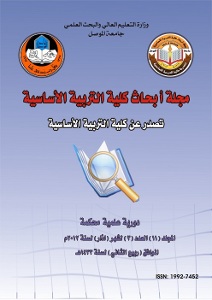Response of Variables of Pulmonary Ventilation After the Performance of Aerobic and Anaerobic Efforts
Abstract
: - .- - . (8) : ( ( ) ( ) ( )) . : ( () () ). :- .- .- ( ) .The current research aims at:1. Discovering the statistic differences between the pulmonary ventilation (VE) responses according to respiratory tidal volume (VT) and respiratory rate (RR) after aerobic effort.2. Discovering the statistic differences between the (VE) responses according to (VT) and (RR) after anaerobic effort.3. Discovering the statistic differences between the aerobic and anaerobic efforts in the (VE) responses according to (VT) and (RR).To verify the hypotheses, the researchers have adopted the descriptive design due to its appropriateness. The sample has been chosen intentionally, Consisted of (8) homogeneous male students of physical education College - University of Mosul (to represent participants of athletic activity).The researchers have used the following measurement and tests to collect data: (Physical tests Using Treadmill (aerobic and anaerobic tests), Anthropometric Measurements (height and weight Measurements) and Physiological Measurements (measuring variables of pulmonary ventilation).The experiment has been done in two days, the first day where the anaerobic effort was done as for the second day, the aerobic effort was done. The researchers have used the following statistical equations: means, standard deviation, coefficient of variance, depended T. test and peered T. test.Knowing the above mentioned facts, the researchers have concluded the following:1. The aerobic effort would cause a significant increase in pulmonary ventilation (VE) , tidal volume (VT), and respiratory rate (RR).2. The anaerobic effort would cause a significant increase in pulmonary ventilation (VE) , tidal volume (VT), and respiratory rate (RR)3. The nature of physical effort exerted (aerobic and anaerobic) has no noticeable effect on responses to changes in pulmonary ventilation , tidal volume (VT), and respiratory rate (RR).
